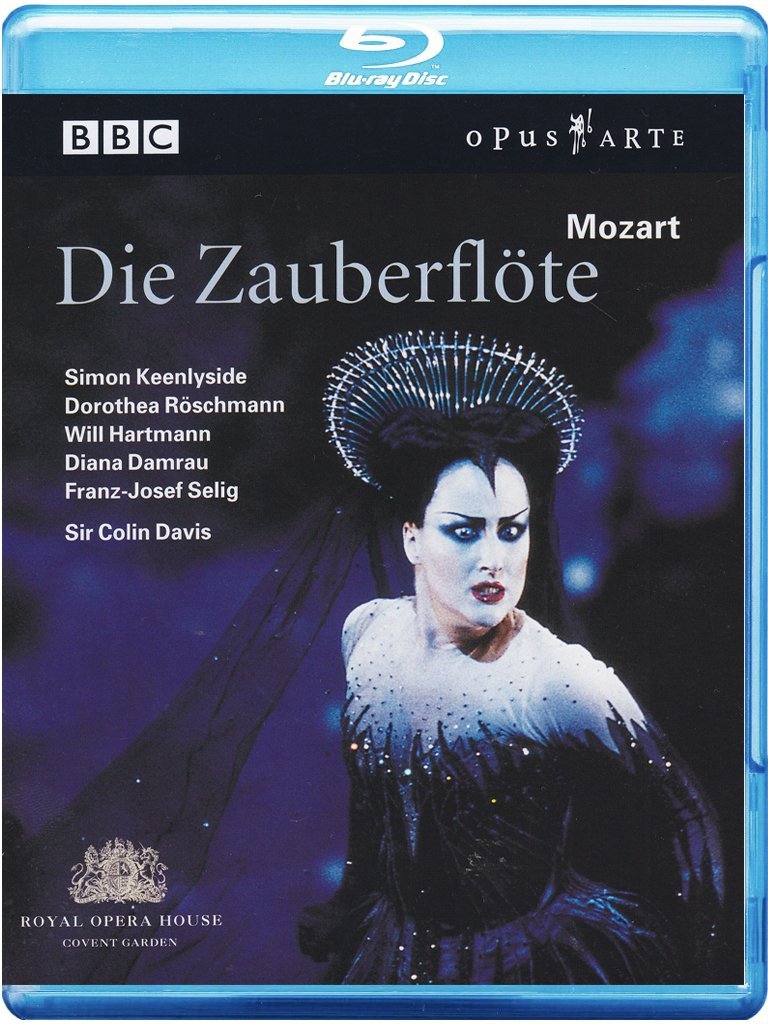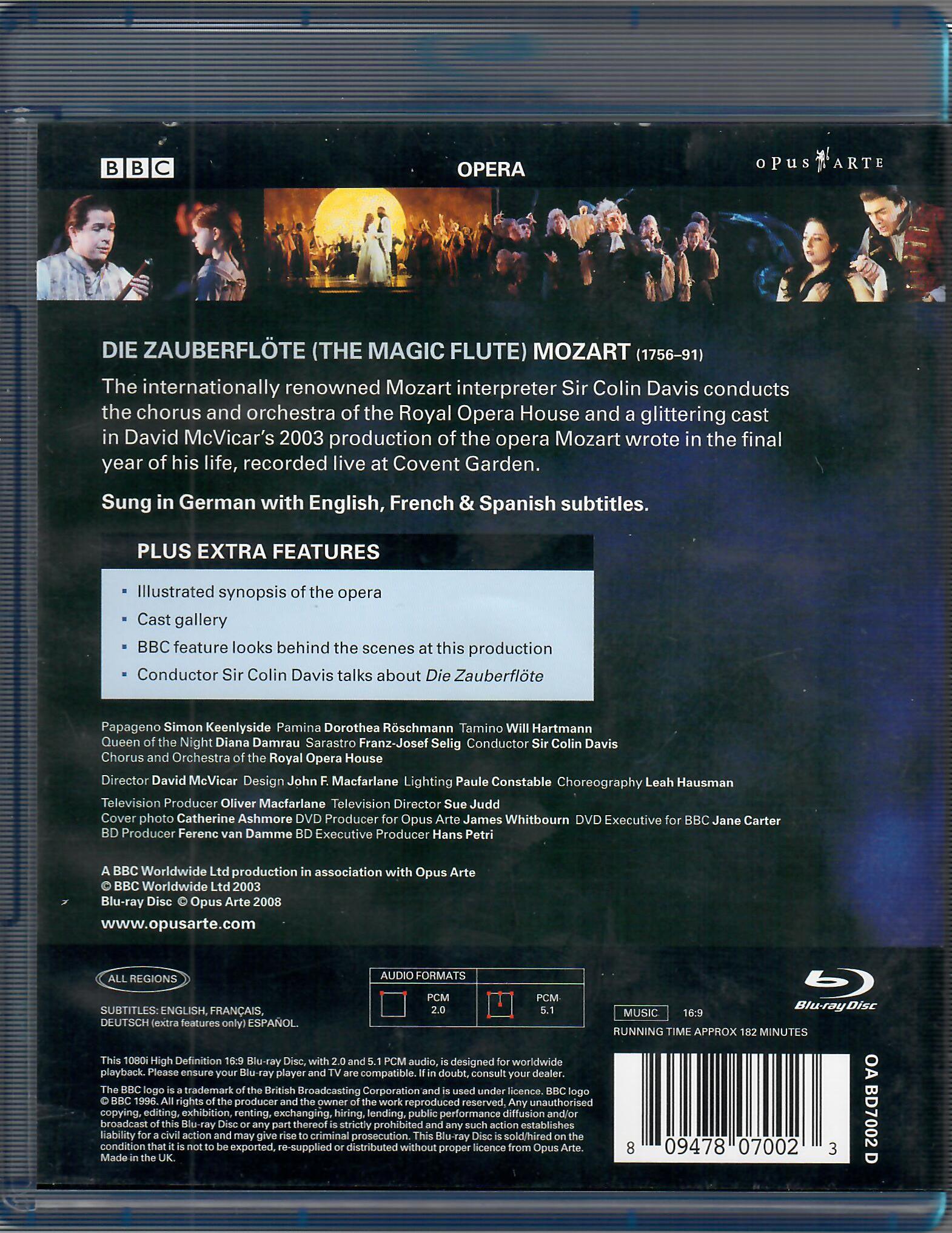

Mozart Die Zauberflöte (the Magic Flute) opera to libretto by Emanuel Schikaneder. Directed 2003 by David McVicar at the Royal Opera House. Stars Will Hartmann (Tamino), Dorothea Röschmann (Pamina), Diana Damrau (Queen of the Night), Franz-Josef Selig (Sarastro), Simon Keenlyside (Papageno), Ailish Tynan (Papagena), Adrian Thompson (Monostatos), Gillian Webster (First Lady), Christine Rice (Second Lady), Yvonne Howard (Third Lady), Thomas Allen (Speaker of the Temple), Matthew Beale (First Priest), Richard Van Allan (Second Priest), Alan Oke (First Man in Armour), Graeme Broadbent (Second Man in Armour), Zico Shaker (First Boy), Tom Chapman (Second Boy), and John Holland-Avery (Third Boy). Sir Colin Davis directs the Orchestra of the Royal Opera House (Concert Master Vasko Vassilev) and the Royal Opera Chorus (Chorus Director Terry Edwards). Design by John F. Macfarlane; lighting design by Paule Constable; choreography by Leah Hausman. Directed for TV by Sue Judd; produced by Oliver Macfarlane. Sung in German. This is the Blu-ray version, released 2008, of the Zauberflöte that Opus Arte also published in HD DVD. Disc has 5.1 PCM audio. Grade: A
Die Zauberflöte is a long opera packed full of action and wonderful music. Contrary to what you may have read, the opera is completely logical (as a fantasy tale) if you go to the trouble to read all the spoken recitatives as well as all the singing parts. If you would like to learn more about the plot of this opera, see my complete story of the Zauberflöte in outline form, which tells the whole story. This ROH production follows the score and libretto pretty closely, so its a good way to learn this opera.
Now for a few screen shots that can at best only hint at the richness of Die Zauberflöte. My comments to the screenshots are partly factual, partly my attempts to simplify the plot, and party bizarre ideas that come to mind as I study this work.
As the opera opens, Prince Tamino (Will Hartmann) is chased by a reptilian monster. Stage hands can be seen manipulating the prop. This happens throughout the whole show; but after a while, you don't see the stage hands any more:
The Three Ladies (left to right Christine Rice, Yvonne Howard, and Gillian Webster) save Tamino. They are the faithful retainers of the Queen of the Night. This video was shot in 2003, early in the HDVD era. McVicar, Macfarlane, and Constable were not thinking about helping cameramen when they filled the stage with smoke and pointed lights across the stage as you see here. The smoke eventually dissipates, but the low lighting (which probably looked great live) continues to be a challenge for the camera crews throughout much of the production.
And at least one camera could not keep things in focus across the whole stage; here only the Lady in the middle is in focus:
Papageno (Simon Keenlyside) is dressed like a tramp with duck-decoy hat, so he isn't very "bird-like." He's a bird catcher, but now he's only interested in catching a woman. Keenlyside is successful at getting your sympathy and also has a quiet flair for physical comedy. Here the Ladies (left to right Gillian Webster, Christine Rice, and Yvonne Howard) have slapped a lock on his mouth because he falsely claimed to have killed the reptile:
The Queen of the Night (Diana Damrau) appears to size up this Prince who has wandered by:
In real life, Damrau is a pleasant, timid-looking, unremarkable blond. It's astonishing what the wig, makeup, and costumes folks can do. Now she looks like Darth Vador's mistress. Damrau is one of the very best actresses among the big-time sopranos who were singing in the first decade of the 21st century. I've seen several other productions of Zauberflöte. Based on what I've seen and read, Damrau's version here of Queen of the Night is in a class by itself. At this point in the show, Tamino has already fallen in love with a picture of Pamina, the daughter of the Queen. The Queen laments that Pamina has been abducted:
Damrau's role is short. The soprano who carries the opera on her back is Dorothea Röschmann as Pamina. And, of course, Röschmann is also one of the very best actresses among the big-time sopranos who were singing in the first decade of the 21st century. Tamino sends Papageno out as a scout to find Pamina. He finds her at Sarastro's castle. This shot is from the sublime Papageno/Pamina "friendship duet" before the Finale to Act 1:
Here's the famous "Orpheus scene" where Tamino charms the animals by playing the magic flute. The design of this show is an odd mix of industrial grunge and 18-century themes. After a while, I enjoyed the look; still, I never could get cozy with idea of all the animals rendered in hard, plastic masks like the tiger here:
Monostatos works for Sarastro and is Pamina's warden. Monostatos in Mozart's production was black. He was originally a slave, but had worked his way up to the job of foreman of slaves. His name means "One Status," which is ironic since he is born opportunist with a great track record at getting ahead. When he is punished by his master Sarastro, he goes over to the camp of the Queen of the Night, who then promises him the hand of Pamina in marriage! Monostatos is a self-made man in a world of wimps who need magic to accomplish anything. Well, McVicar decided not to get into all that. His Monostanos (Adrian Thompson) isn't black---he's just strange: here he and his charges are bewitched by Papageno's magic bells:
Sarastro (Franz-Josef Selig) arrives. When the King died, he gave Sarastro the Seven Solar Secrets (my translation) and asked him to supervise, as the King's executor, both the Queen of the Night and Pamina. This was not a good estate plan because the Queen has her own ideas about how things should be handled. Above all else, the Queen wants the Seven Solar Secrets back (doesn't that sound like something that should be in the custody of the Strategic Air Command?):
Sarastro sequestered Pamina for her protection. Now Sarastro needs Tamino as an ally, because Sarastro and all his friends (the Initiated) are getting close to retirement age. Pamina wants to return to her mother, but Sarastro now aims to keep her as a bride for Tamino:
Sarastro blesses Pamina, who is pretty confused girl:
Tamino must be initiated if he is to be Sarastro's confidant and heir to the Seven Solar Secrets. This shot shows the Speaker of the Temple (Thomas Allen) in consultation with Sarastro about this:
The struggle between the Queen and Sarastro is coming to a head. The Queen appears and lays out Pamina's options. Pamina must murder Sarastro or:
In the meantime, Tamino has survived several trials as part of his initiation. Sarastro in a famous trio begins the final tests of fire and water for Tamino. With the help of the magic flute, Tamino and Pamino endure the ordeals and become members of the Temple:
Papageno has been left behind in his misery. He decides to settle for the best he can do:
But he is finally rewarded by a beautiful, young Papagena:
The Queen, Monostatos, and the Three Ladies make a last-ditch effort to attack Sarastro and grab the Seven Solar Secrets. Below Monostatos and the Ladies renew their oath of allegiance to the Queen in 12 bars of some of the creepiest music ever written. This reminds me of an event to come in 1934. All the officers in the German military had taken an oath to defend the German constitution. But then each officer had to make a choice: replace the old oath with a new oath to Adolph Hitler personally---or leave the country. They took the Hitler oath in mass ceremonies. If you ever want to depict this in a movie, Mozart has the background music for you.
Here's a nice HD clip of the Queen of the Night from this production:
OR





















